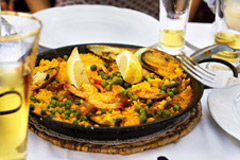Spanish food recipes
Mention Spanish food and everyone picture paella in their minds; some will also be reminded of tapas; and it will conjure the smell of salt and pine trees along with images of deep blue water shinning under the sea so common to the Mediterranean Spanish coast. Spanish food is all that, but travel across the country and dare to try some of the local dishes. You will be hooked.
The recipes you will find here are the ones that travel well. Those based on, either, ingredients found in any grocery store, or typical Spanish ingredients easy to find, and that will retain their Spanish charm. Unhappily, not all recipes can be recreated in other countries. We’ll try to mention those, so you can put them to the test if you visit.
Tapas are little bites to accompany a glass of wine or beer. The word has also become a verb –tapear- meaning the bar hopping routine Spaniards indulge, particularly in the early evening. Tapas are also a relaxed way to entertain at home.
Soups range from warm and filling –think of the Castilian garlic soup- to the cool gazpacho, or I should say gazpachos, because there are almost as many versions as people in Spain. Beans and potatoes cannot be though of as modest fare any more; they provide the basis for incredibly warming winter soups known as potajes.
Irresistible salads, usually dressed with the finest extra virgin olive oil and not much more, so simple to prepare and so satisfying.
Eggs are a chapter apart. Eggs don’t usually make it to the breakfast table in Spain, they will pop up as mid morning snack, lunch, dinner, late supper, or dessert –from the potato based Spanish omelet to the traditional flan.
Empanadas and bread based dishes are extremely popular. In Mallorca, empanadas come covered with sobrasada –a mixture of pork meat, lard and paprika- and sugar. In Alicante, empanadas are open; their cocas and remind of Italian pizza. In Galicia, they filling will likely be sardines, tuna or clams.
Fish and seafood are at the core of the Spanish diet. Apart from the steaming or grilling, you will find in Spain seaweed omelets, squid cooked in its ink, about as many recipes for salt cod as for gazpacho, or a whole fish cooked in salt.
Meat means pork over all, lamb is very seasonal, and beef is not for every day either.
From the poultry counter, chicken is the most common order. Spain has always been rich in small game meat, and partridge, quail, pheasant, duck, hare or rabbits hang by the side. Turkey is a relatively recent addition to the Spanish menu. Not many years ago, you had to order so much in advance that you would think they raised a bird from the egg at that point. It is now a common sight.
Rice and pasta are staples in the Spanish diet. After all, you cannot write about Spanish recipes and not give at least one for paella. Be advised, the same simple cooking technique has given rise to as many recipes for rice as there are for gazpacho and salt cod together.
Vegetables appear more as an appetizer or a first course than a side dish. You will find some very sophisticated recipes. Do you know about menestras?
Desserts tilt more to the side of creams, custards, mousses, ice creams, granitas than to the pie and cake side. Cakes and pasties are seen as something for mid afternoon snack or breakfast time.
Spanish food is much more than paellas.

